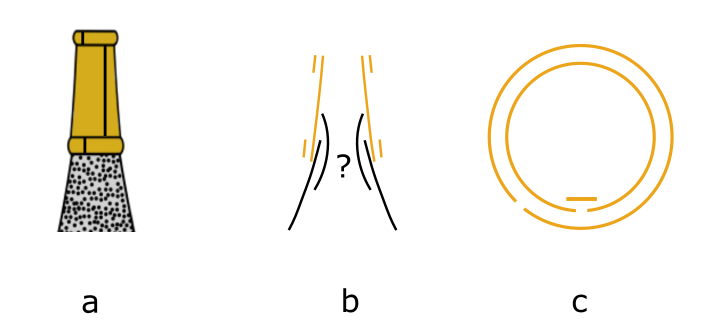Introduction
As part of the preparation of the Catalog of European helmets of 9th-12th century, we had the opportunity to personally inspect one of the best preserved helmets of the Black Mound type, originating from the locality Gorzuchy, Poland. The three-hour examination, which took place on Monday, May 9, 2022 in the building of the National Museum in Krakow (Muzeum Narodowe v Krakowie) with the participation of museum staff and photographer János Mestellér (Kazár Bazár), helped to modify and supplement some previously published information. In the following article, we present the most detailed publication of this find so far. All works are created with the consent of the above-mentioned museum and of Jagiellonian University Museum (Muzeum Uniwersytetu Jagiellońskiego) to whose collections the object belongs.
The helmet from Gorzuchy. Photo by János Mestellér.
Previous publications
Considering the age and preservation of the find, the helmet is one of the most published European helmets. At least five authors published it before 1900, namely Szaniawski (1873), Sadowski (1877: 3-4, Tabl. III), Eljasz-Radzikowski (1879: Tabl. XI.3), Kohn – Mehlis (1879: 209) and Starzyński (1875-1900: 4-5). Other Polish authors who managed to publish it before the World War II were Cercha (et al. 1904: 15), Gembarzewski (1923: 261-2) and Bocheński (1930: Tabl. I, Ryc. 1-2; 1935: 321). Sommerfeld-Sarnowska’s article (1948: Tabl. LX) was also written before the war, but was not published until after the war. Other notable titles of the Polish academia were published by Nadolski (1954: 71; 1960; 1994: 63), Rajewski (1973: 350), Żygulski (1982: 78, Il. 2), Wawrzonowska (1982: Ryc. 98), Grabowska (1991: 59-61), Nowakowski (1991: 85, 135), Rychter – Strzyż (Rychter– Strzyż 2016: Fig. 10.2), Poklewska-Koziełł – Sikora (2018: Ryc. 6.1), Engel – Sobczak (2019: Ryc. 6.2) and Górewicz (2020: 480, Ryc. 10.29). Abroad, for example, Niederle (1925: 579, Obr. 163), Kirpičnikov (1958: 54, Рис. 1.4, 4.3; 2009: 15-6, Рис. 18.1, 19-21, 23), Hejdová (1964: 80, Obr. 20.6), Nicolle (1999: Fig. 890; Nicolle – Sarnecki 2008: 20), Wieczorek – Hinz (2000: 392-3), Gorelik (2002: Fig. XI-14.14), Brather (2008: 299) and Papakin (2017; et al. 2017: № 11; 2019: 56, Il. 2.1) decribed the helmet.
Generally speaking, it can be argued that the vast majority of the literature focuses only on the mention of the helmet, or size, approximate dating and a photo of the rear or side segments. We consider Bocheński (1930) to be the most valuable work, whose study is largely consistent with our findings. Also, the entry in the catalog of Wieczorek and Hinz (2000: 392-3) is a quality source of information with the best photograph published so far. None of the titles named mentioned the weight and view of the inside of the helmet. The literature seems to agree on dating to 10th-11th century, but the place of origin has been the subject of protracted disputes in the past.


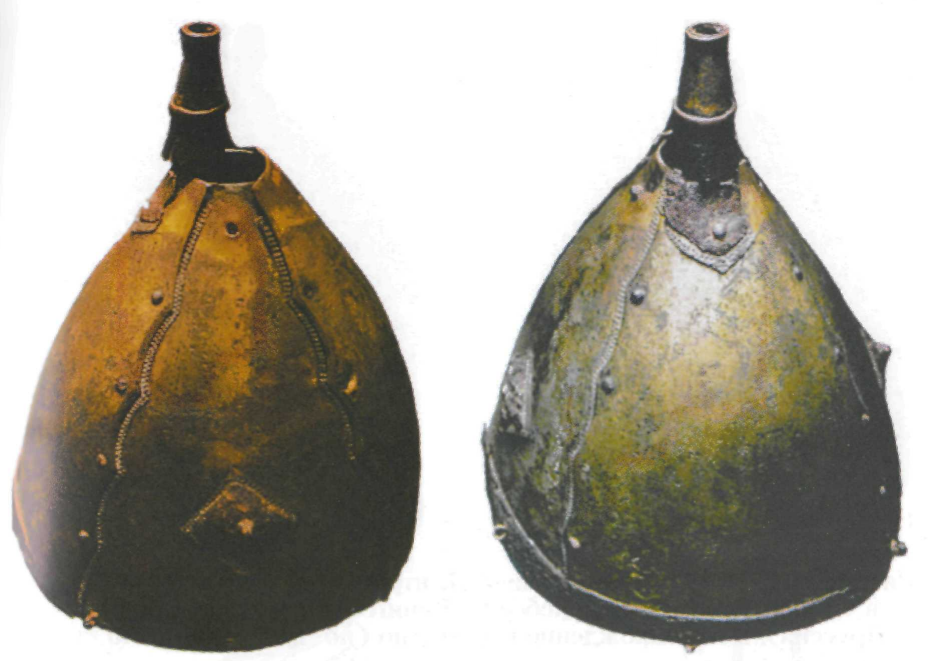
Archive photos of the helmet from Gorzuchy.
Source: Bocheński 1930: Tabl. I; Żygulski 1982: 78, Il. 2; Kirpičnikov 2009: Рис. 23.
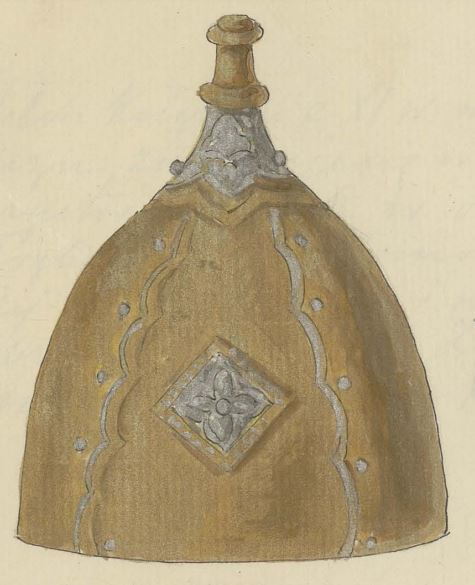





Various drawn reconstructions of the helmet.
Source: Starzyński 1875-1900: 4-5; Cercha et al. 1904: 15; Bocheński 1930: Ryc. 3; Nadolski 1994: 63; Kirpičnikov 2009: Рис. 21; Górewicz 2020: Ryc. 10.29.
Circumstances of the finding and place of storage
The helmet was accidentally discovered in the summer of 1866 while fertilizing a field in the village of Gorzuchy (Kalisz district, Greater Poland Voivodeship). Together with the helmet, the remains of a mail were found – an aventail or body armour – the further fate of which is unknown today. In the literature we find two variants of the fate of the helmet. According to one, the object remained in the collection of Edward Rastawiecki until 1868, according to the other, it belonged to Aleksandr Przeździecki until 1871. In any case, it was handed over to the Archeological Cabinet of the Jagiellonian University in Krakow, and the helmet is currently part of the collection of the Jagiellonian University Museum. Inv. No. 16417. It is permanently exhibited in the National Museum in Krakow, Inv. No. MNK 6023.
Position of Gorzuchy on the map of Europe.
Construction and metric data
The Gorzuchy helmet is one of the best-preserved examples of its kind, and although it has partially suffered over time, it still retains a high informative value. Among the most significant defects of the helmet, there are the missing trident, the almost unpreserved iron core of the S1 segment, a partially absent rim, a damaged socket, and varying quality of preservation of the gilding and riveting.


Schematic view of all four sides of the helmet. Author: Michal Havelka, baba_jaga_atelier.
Higher resolution of segments S1 and S2. Higher resolution of segments S3 and S4.









A view of all four segments of the helmet. Photos by János Mestellér.
The dome takes on a spheroconic shape with a total height of 20.5 cm. The original height with the socket was most likely around 30 cm. The helmet is slightly compressed in the forehead-nape line, so that instead of an oval cross-section, it has a circular impression with maximum internal dimensions of 20.3 × 20.3 cm. The dome is made up of four triangular segments, with the front and back segments overlapping the side ones. The length of the overlap of the segments was not the subject of our documentation, but it can be estimated that it is not longer than 2 cm. The width of all the segments is approximately identical (S1 width along the outer circumference = 17 cm). Due to incomplete preservation, we managed to set the circumference only in general at approximately 64.5 cm, from which it can be concluded that the helmet is suitable for wearers with a head circumference of approximately 57-59 cm. The weight of the helmet in its current state is set at 0.776 kg (dome: 0.743 kg, socket 0.033 kg).
The side edges of the front and rear segments are provided with four decorative lobes, while the edges of the side segments are left unadorned. The holes in the segments show a diameter of up to 0.4 cm (N2) and some holes are punched from the inside outwards of the dome. The segments are covered with gold-plated copper alloy plates, the folds of which are visible on the inside, where they overlap to a distance of about 0.3-0.36 cm. The gilding is still well preserved in some places and the copper alloy plates are not mechanically damaged and not separated from the iron segments. The segments are 0.14-0.22 cm thick at the edges, which also includes the cover on both sides. The cover is 0.07 cm thick (S1). The front segment does not appear to be thicker than the other segments (S1: 0.146 cm; S2: 0.17 cm; S3: 0.214 cm; S4: 0.18 cm). The thickness of the iron parts of the uncoated segments is probably not far from 0.1 cm.
In the protrusions of the lobes there are mushroom head (N5) and flat head rivets (N1) with a diameter of 0.5-0.7 cm (see Appendix 2) and a height of up to 0.2-0.3 cm. Inside the dome, the rivets are hammered flat. The upper row of rivets (N1, N5, N9, N13) is 3.9-4.4 cm far from the second row (N2, N6, N10, N14), the second row is 3.4-4.1 cm far from the third row (N3, N7, N11, N15), the third row is 3.5-4.1 cm far from the fourth, the lowest row (N4, N8, N12, N16) and the lowest row of rivets is 4.2-5.55 cm above the edge of the helmet. There are engraved grooves between the rivets along the edges of the segments, especially along the rivets connecting S2 and S3. The very edges of the segments are chamfered outside these grooves, the width of the chamfer is approximately 0.26-0.32 cm. Prior to the final assembly, the overlap of the segments was interspersed with embossed strips of non-gilded copper alloy, which copy the shape of the side edges of the segments and are also lobed. The width of these strips is relatively uniform, 0.6 cm at minimum. The strips are not visible from the inside, they extend by approx. 0.2-0.3 cm out of the segments and are decorated by two-row holes, which were made with a double-point stamp.



Detail of lobes and interlaid strip. Photos by János Mestellér.
The hole at the top of the helmet was originally covered by a massive, tall and hollow socket whose remnants are partly attached to the S3 segment, partly formed by a separate piece. The orientation of the separate piece cannot be determined today. Seen from above, the base of the socket had the shape of a four-pointed, slightly oval star with a maximum width of 8.1 × 7.1 cm (calculated on the basis of its imprint including the underlay). It was attached to the helmet dome with four rivets with a mushroom head with an approximate diameter of 0.5 cm, one for each segment (see Appendix 2). The height of the socket without the underlay was at least 9 cm (today 2.76 cm + 6.24 cm). The distance of the holes for fixing the socket from the upper edge of the segments is 1.83-2.1 cm. The thickness of the preserved parts of the socket is 0.137 cm. The edges of the sleeve are not chamfered, but they have a perimeter line. The surface of the socket was covered with a silver foil, which was fixed by means of a randomly arranged grid of dots. The foil was decorated with a floral ornament, while our observation corresponds to Bocheński’s drawing, but the ornament was more developed and it is not possible to fully reconstruct it today. The underlay of the socket was made of an embossed copper alloy strip and the same punch was used for embossing as on the other embossed strips. The narrowest point of the preserved underlay is 0.82 cm wide. The lining was made of one piece, which was wrapped clockwise around the entire helmet and its ends were folded over each other. The overlap, at least 1.2 cm long, is located on the rear segment (S3), ie it is intentionally placed in the least visible place.
The top of the separate piece of socket is probably the best researchable find of its kind and offers interesting results. The socket is at least two-piece; its iron base is extended by a band of gilded copper alloy, the ends of which are not folded over each other, but lined on the inside with a small rectangular strip, to which the ends are apparently soldered or attached by a similar method. From the outside, this joint creates a thin, barely perceptible dark line. Rings were placed on both ends of the resulting tube, the ends of which were connected using the same technique. The joints of the two rings are aligned, which is slightly deviated from the joint of the base tube. The presence of rivets was not confirmed by visual inspection. The height of the rings is approximately 0.56 cm, the distance between the rings is 2.61 cm. The hole at the top of the socket, with a diameter of less than 1 cm, was not, it seems, covered by a perforated cap, but was hollow (today it is filled with a red strengthening restoration material). A look inside the separate part could suggest that the joint of the two main parts of the socket could have been strengthened by a third part that was attached by an unknown method, but this assumption must be confirmed by non-invasive technical analysis.


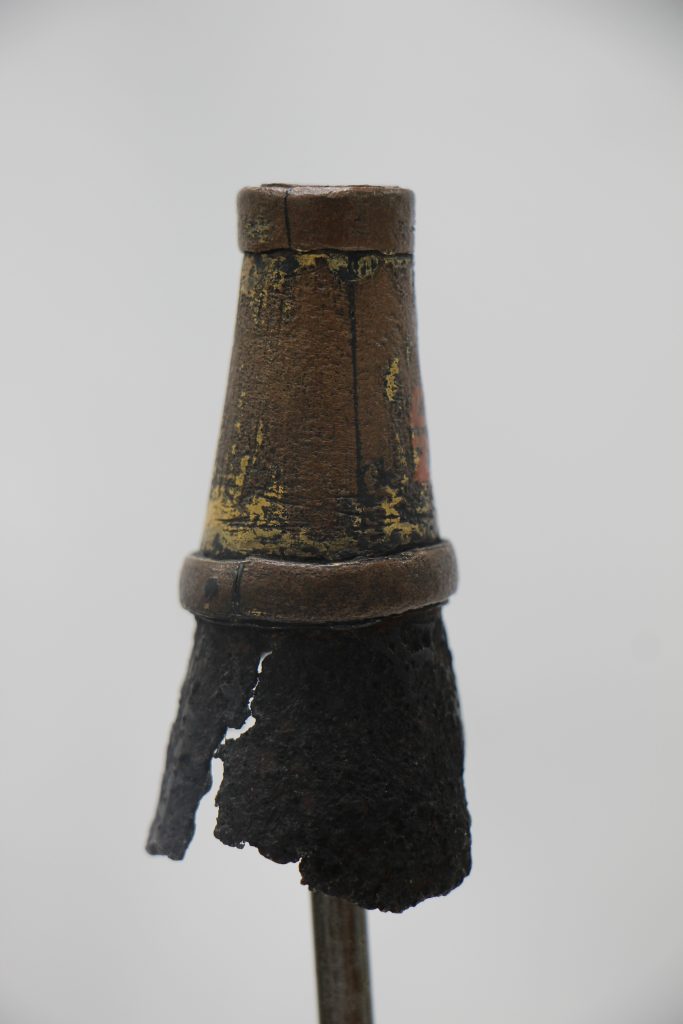
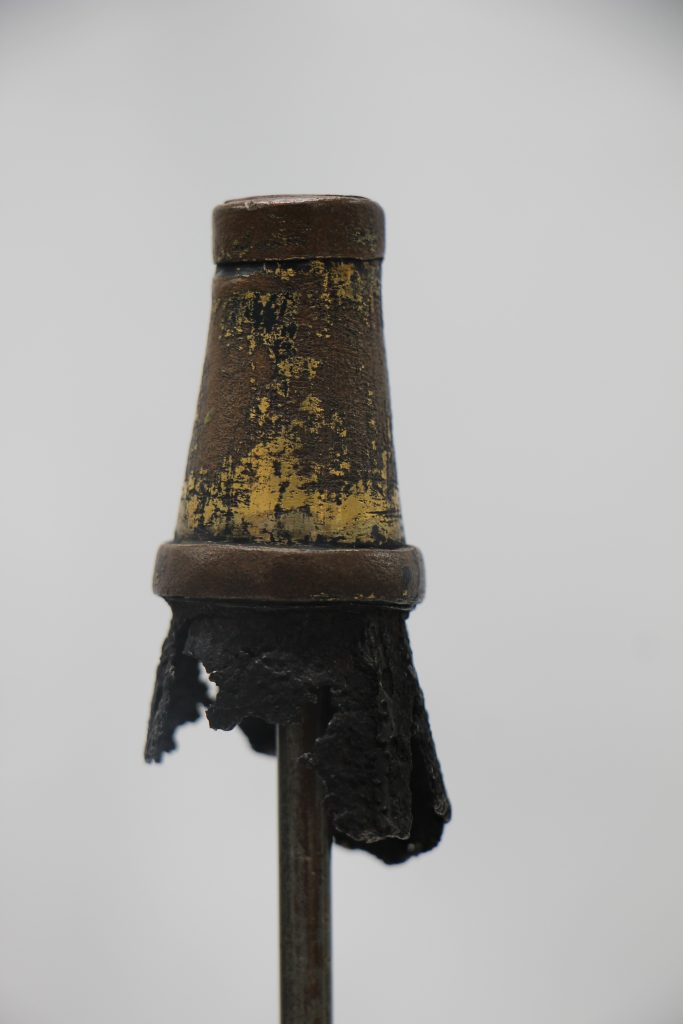


Detail of the socket. Photos by János Mestellér.
The front segment (S1) used to be dominated by a reinforcement that closely copied the face – a trident with a rectangular base and one central and two lateral teeth. The exact shape of the side teeth is unknown, as the trident has not been preserved and is only visible from the impression. The shape proposed by Bocheński can be roughly confirmed. The length of the base as the crow flies is 12.7 cm, in the arc approx. 14.5 cm. The base was fixed at three points, while the outer holes (O1, O11) were also eyelets with a distance of less than 11 cm, while the central hole was probably filled with a rivet. The position of the holes of this trident base is slightly asymmetrical (see Appendix 2). The lower edge of the trident does not appear to be equipped with a small arch to fit into the space between the wearer’s eyes. The arrow-shaped central tooth was prominent and, with underlay, reached over half the height of the dome, 10.7 cm above the edge, and in its center we find a single rivet hole. The side teeth, reaching a height of approximately 8.1 cm, were undoubtedly of a more subtle nature and were therefore not fastened with rivets. The trident was undoubtedly iron, underlaid with embossed bands of copper alloy and covered with silver foil affixed by punching. A preserved impression suggests the opening of the trident by five symmetrically placed openings of triangle and diamond shapes, which revealed either the contrasting lining or the contrasting cover of the helmet dome.



Detail of the trident. Photos by János Mestellér.
The rim of the helmet was surrounded by an iron rim, which is only partially preserved today, and had a constant width close to 2.3 cm and a thickness of up to 0.2 cm. It was fastened with eleven eyelets placed in the holes (S1: 2; S2: 4, S3: 2; S4: 3), while the eyelets on the frontal segment (S1) simultaneously held the sides of the trident, under which the rim was inserted. The spacing of the O1-O11 eyes is irregular and varies between 3.7-7 cm (see Appendix 2). A total of six eyes are preserved (O4, O5, O6, O7, O8, O9), some more completely (O4, O6, O7, O8), others only as corroded pieces of wire in the holes (O5, O9). Most of the eyelets are made of iron wire up to 0.3 cm wide (O8) and up to 0.25 cm thick (O4) and have the classic omega shape (their shape are clearly visible inside the helmet), but one eyelet (O7) is made made of copper alloy and there is no bend inside the helmet. The functional aspect of this eyelet, which is made of material 0.37 cm thick and 0.21 cm thick, remains unknown. The eyelet cannot be removed from the edge of the helmet. The eyelets are located approximately 0.7 cm above the edge. The rim was originally covered with silver foil above the eyelet level, which was attached using the still visible dotting, which was lined with two lines. The rim, originally apparently lined with a embossed copper alloy band, has apparently been reinstalled and in during the modification this lining was removed, causing the rim being loose. The separation from the dome is solved in an interesting and unique way – a rivet was placed in the hole located above the rim and below the rosette on the S2 segment, which holds the rim from above. The copper alloy eyelet may also be related to the rim modification.


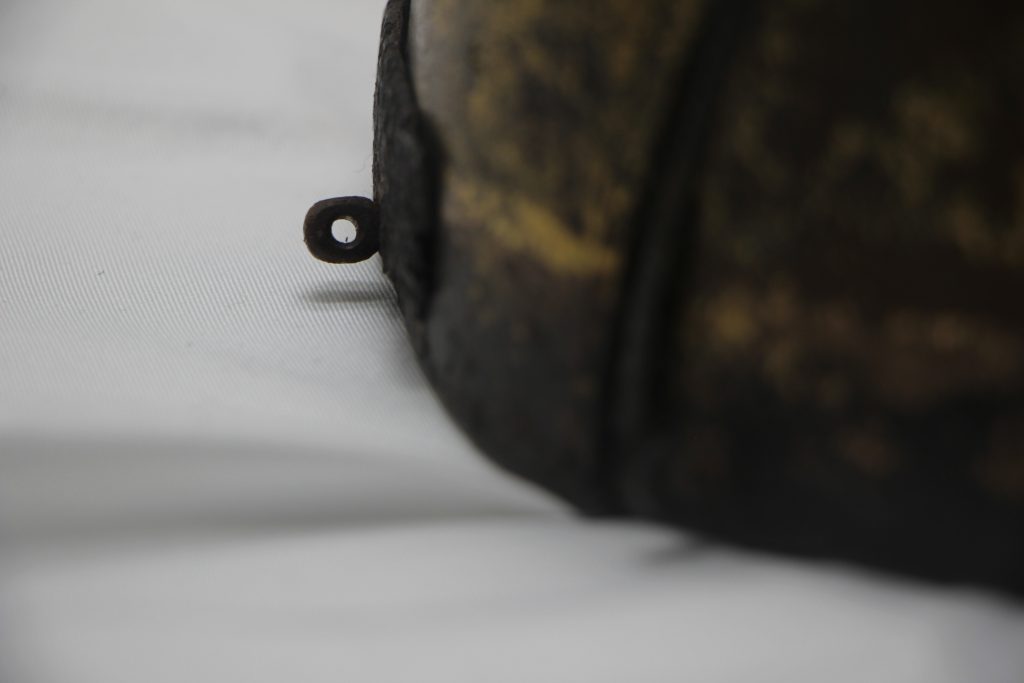



Helmet edge details. Photos by János Mestellér.
The side segments were decorated with iron, hollow rosettes, which are still preserved today (the rosette located on S2 is better preserved than the rosette from S4). The rosette of the left segment (S2) measures 5.39 × 5.39 cm with the underlay, while the rosette of the right segment (S4) measures 5 × 5.45 cm. The length of the underlay is 3.7-3.8 cm. The rosettes have a height of 4.4 cm, a side length of 3.66 cm and a diagonal between the narrowest sides of 3.06 cm. The shape of the rosettes and the underlay made of stamped copper alloy plates is close to a rhombus. The thickness of the iron material of the rosette cannot be determined well due to its arching, but it reaches a height of approx. 0.4 cm. The edges of the rosettes are not sharply beveled, but they slope continuously and are bordered by a perimeter line that forms the motif of a four-pointed star. The surface of the rosettes was coated with silver foil, which was attached, similar to other iron elements of the helmet, by random dots placed in the star motif. The rosettes are held by central, pointed rivets with a circular or slightly oval base. Both rivets appear to be completely iron. The rivet on the S2 segment is better preserved, with a height of 0.62 cm and a diameter of 0.77 cm. It cannot be ruled out that the rivets were originally coated with non-ferrous metals. The height of the center of the rivets above the edge of the helmet is 6.73 cm and 7 cm.



Details of the preserved rosettes. Photos by János Mestellér.
It follows from the text that all the iron details riveted to the dome were of similar thickness and were covered with silver foil and underlaid with embossed strips. The materials were intentionally layered to create maximum contrast.


A graphic reconstruction of the approximate appearance of the helmet before the supposed modification. Author: Michal Havelka, baba_jaga_atelier.
Higher resolution of segments S1 and S2. Higher resolution of segments S3 and S4.
Schematic drawing of the the socket. Author: Michal Havelka, baba_jaga_atelier.
a – orientation of the joints when viewed from the front.
b – the assumed cross-section of the socket when viewed from the front.
c – the assumed cross-section of the socket in the top view.
Higher resolution of the drawing.
Appendices
Appendix 1: All photos taken during the documentation.
Appendix 2: rivet diameters, rivet center distances, loop distances.
Comparison with analogies
The helmet from Gorzuchy can be easily assigned to helmets of the so-called Black Mound type, as suggested by Papakin (2017; 2019; et al. 2017), or Kirpičnikov type II (Kirpičnikov 1958; 1971; 2008; 2009). In the total number of approximately 70 pieces and fragments from the area from Poland to the Urals, from Novgorod to Bulgaria and the North Caucasus, the helmet is one of the best preserved specimens of this type and some of its iron parts are extremely beneficial for the study of this type.
The construction of the dome can be assessed in all respects as standard and non-deviating from a series of helmets with a gilded cover. The only minor feature that distinguishes the Gorzuchy helmet is the engraved lines between the rivets connecting the segments. Similar lines are not typical for the material in the known corpus, but we must add that many helmets have never been professionally researched (they are in a very damaged condition, were destroyed during the wars or ended up in private collections). We can say for sure the same lines are visible at Olszówka helmet and it seems from the photos that the helmet from Groß Friedrichsberg (Gaerte 1923; Gaerte1924a: 135-141; Gaerte 1924) could potentially have the same feature. The preserved socket is a rare find in the corpus of Black Mound helmets and in general it can be said that the height and shape of the socket put the discussed helmet among typical specimens, but due to the small number of preserved sockets the search for parallels is limited – similar are known from the Black Mound (Kovalenko et al. 2020), Groß Friedrichsberg, Babrujsk (Ovsejčik 2021), Olszówka and unknown Russian site (Kirpičnikov 2009: 6-8, Рис. 1-4). The multi-part construction of the socket is particularly visible on the helmet from the Black Mound and Groß Friedrichsberg, the latter being also equipped with a gilded band, which contrasted with the silver base of the socket. An organic plume was inserted into the socket opening.
Construction of the helmet socket from the Black Mound. Source: Kovalenko et al. 2020: Рис. 8.

Helmet from Groß Friedrichsberg. Source: Bocheński 1930: Tabl. III.
As for the trident, a prominent central tooth surrounded by smaller teeth is a typical feature of this type. Each trident is quite unique, so finding a direct parallel is an impossible task. However, if we try this task, the tridents of helmets from Groß Friedrichsberg (also known from an imprint) and Mykolaiv region (Kainov 2018: 48-9, Рис 3) are very similar in shape. The openwork decoration can further be detected on an unpublished helmet from Leninskij Puť (Novorossiysk Historical Museum, inv. No. НМ 7216/35; see Goskatalog 2020), Gelendzhik helmet (Gelendzhik Museum of National History, inv. no. A-2776), Olszówka helmet, Mokre helmet and a helmet from Brodivsky district (Vlasatý 2020).
Approximate shape of a helmet trident from Groß Friedrichsberg.
Source: Kulakov 1999: Рис. 2.
The straight rim, which is inserted under the trident and which is held only by wire eyelets, has numerous parallels in the set. The closest ones include helmets from Groß Friedrichsberg, Kyiv region (Papakin et al. 2017: № 19), quite possibly Ekritten (Goßler 2013a) and Makariv district (Papakin et al. 2017: № 18). Wavy rims held be the same way come from Babrujsk, Mokre, Manvelivka (Čurilova 1986) and potentially also Giecz (Poklewska-Koziełł – Sikora 2018). Within the ensemble we also find helmets with an openwork rim, finished on both sides with an arch, which is fastened with eyelets – these come from the localities Walric (Beard 1922), Brodivsky district and potentially Opava-Jaktař (Kouřil 1994: 46, Fig. 24.10). Undoubtedly, one piece from Novgorod had a system of eyelets (Kainov – Kamenskij 2013: Рис. 3-4), but it is not possible to determine to which shape of the rim it belonged. As for the hole preserved above the rim, for the Black Mound type we know at least five other helmets with similar holes – Brodivsky district, Babrujsk, Olszówka, Makarivsky district, Walric. At least two other helmets in the corpus are equipped with rivets located in the same place – Rajkoveckoe fortress (Gončarov 1950: 97, Tabl. XV.2-4) and a find from the bank of the Krasnodar dam (Kirpičnikov 2009: 26, Рис. 37-9). All holes are circular and have a maximum diameter of approximately 0.5 cm. It cannot be ruled out that these holes originally participated in the attachment of the padding, but their location in the area of the ears is a good precondition for the theory that this is a way of attaching the chin straps.
Helmet from Babrujsk. Source: Ovsejčik 2021: 19.
Iron, silver-foil rosettes are not unknown – in addition to the find from Gorzuchy, we record eleven finds – Black Mound, Groß Friedrichsberg, Babrujsk, Olszówka, Giecz, Szurpiły (Engel – Sobczak 2019: 71-2, Ryc. 4.1) and three detector finds from Ukraine (Kirpičnikov 2009: 26, Рис. 17; Kainov 2018: 50, Рис. 5.1). The most similar pieces are the rosettes from Babrujsk and Szurpiły. The rivets are usually made of a copper alloy, and the only comparable find is a partly iron rivet from Olszówka.

Iron silver-plated rosette from Szurpiły. Source: Engel – Sobczak 2019: Ryc. 2.
The dating of the helmet from Gorzuchy and its nearest gilded parallels is difficult, as the finds come largely from disturbed and archaeologically undocumented situations or from settlement strata. Based on the helmet from the Black Mound, it is generally believed that helmets of this variant can be dated to the last quarter of the 10th and first quarter of the 11th century (Kainov 2022; Lušin 2019; Šišlina et al. 2017; Vasjuta 2016). Some examples appear in mound inventories of the 11th century (Goßler 2013a; Goßler 2013b: 186, Abb. 55). Settlement finds occur as a destroyed torso or as a remodeled helmet until the 13th century (Kainov – Kamenskij 2013). In the context of today’s Poland, in which we know at least 7 helmets of this type or their fragments (Gorzuchy, Giecz, Gniezno, Olszówka, Szurpiły, Walric?), most of the finds are concentrated in the area of Greater Poland. In the 1030s, the use of one-piece conical helmets is already assumed in Poland, which are represented by two water finds from the Lednica and Orchowo lakes (Sankiewicz 2018). For this reason, the reign of Bolesław the Brave (992-1025) appears to be the most logical period for gilded helmets in Greater Poland.
The contribution of the helmet from Gorzuchy
In the past, the helmet played an important role in shaping views on the historical role of Greater Poland and its rulers and was one of the main arguments in support of so-called Greater Poland theory of origin of Black Mound helmets (eg Nadolski 1960), which is now expired. The possibilities of the helmet for historical science are currently more or less depleted, but they are far from depleted for archeology. As mentioned above, Black Mound helmets are usually found in problematic situations and often in very poor condition. The main value of the Gorzuchy helmet lies in the good condition of preservation, which contributes to the knowledge of its details. Damage makes it possible to understand how the underlay overlaps under ferrous applications, which will help to reveal the same solutions in the future for helmets that are better preserved. A well-preserved socket can be a source of very valuable findings. An important new chapter, which is still not open, will be the analysis of the metals used for decoration and the comparison of the results with other helmets in the same group.
Acknowledgment
The documentation of the helmet was made possible for me by the local reenactor Marcelina Bednarz (TYR Hird) and the museum staff, of whom Natalia Bahlawan (Jagiellonian University Museum), Beata Frontczak (ibid.) and Piotr Nowak (National Museum in Krakow) deserve the most sincere thanks. We would like to thank our friend and colleague János Mestellér (Kazár Bazár), who took care of the photos. We are also grateful to Sergei Kainov (State Historical Museum, Moscow) for consulting the material obtained. We must mention Michal Havelka (baba_jaga_atelier), who is the author of the drawn schemes.
I hope you liked reading this article. If you have any question or remark, please contact me or leave a comment below. If you want to learn more and support my work, please, fund my project on Patreon or Paypal.
Bibliography
Beard, C. R. (1922). Ein Helm des 11. Jahrhunderts vom Schlachtfeld zu Walric. In: Zeitschrift für Historische Waffen- und Kostümkunde, B. 9, H. 6/7, Dresden, 217.
Bocheński, Zbigniew (1930). Polskie szyszaki wczesnośredniowieczne, Kraków.
Bocheński, Zbigniew (1935). Nowe materjały do zagadnienia polskich szyszaków wczesnośredniowiecznych. In: Sprawozdania z Czynności i Posiedzeń Akademii Umiejętności w Krakowie, T. 40, Nr. 9, Kraków, 319-321.
Brather, Sebastian (2008). Archäologie der westlichen Slawen: Siedlung, Wirtschaft und Gesellschaft im früh- und hochmittelalterlichen Ostmitteleuropa, Berlin – New York.
Cercha, M. – Cercha, S. – Kopera, F. (1904). Pomniki Krakowa, T. I, Kraków.
Čurilova 1986 = Чурилова, Л. Н. (1986). Погребение с серебряной маской у села Манвеловки на Днепропетровщине // СА, № 4, 261–266.
Eljasz-Radzikowski, Walery (1879). Ubiory w Polsce i u sąsiadów. T. 1, Cz. 1, Od IX do końca XIII wieku. Do końca XI wieku, Kraków.
Engel, Marcin – Sobczak, Cezary (2019). Ozdobne okucia hełmów wczesnośredniowiecznych z zespołu osadniczego w Szurpiłach, In: Acta Militaria Mediaevalia XV, Kraków – Sanok – Wrocław, 65-84.
Gaerte, Wilhelm (1923). Ein altpreußischer Helm. In: Zeitschrift für historische Waffen- und Kostümkunde, Neue Folge, B. 1, H. 2/3, 41-2.
Gaerte, Wilhelm (1924a). Die Besiedlung und Kultur Königsbergs und seiner Umgebung in vorgeschichtlicher Zeit. In: Altpreußische Forschungen, Jg. 1, H. 1., Königsberg, 97-144.
Gaerte, Wilhelm (1924b). Ein altpreußischer Helm — Nachtrag. In: Zeitschrift für historische Waffen- und Kostümkunde, Neue Folge, B. 1, H. 5, 137–138.
Gembarzewski, Bronisław (1926). Muzeum Narodowe w Warszawie : wybór i opis celniejszych zabytków i dzieł sztuki, Kraków.
Gončarov 1950 = Гончаров, В. К. (1950). Райковецкое городище, Киев.
Gorelik, Michael (2002). Arms and armour in South-Eastern Europe in the Second Half of the First Millenium AD. In: Nicolle, David (ed.). Companion to Medieval Arms and Armour, Woodbridge, 127–147.
Górewicz, I. D. (2020). O broni Słowian. Na wojnie i w kulturze, Szczecin – Poznań.
Goskatalog 2020 = Шлем (фрагмент). In: Государственный каталог Музейного фонда Российской Федерации [online]. [2020-10-08]. Available from: https://goskatalog.ru/portal/#/collections?id=26915979.
Goßler, Norbert (2013a). Wieder gefunden: ein Helmfragment aus Ekritten. In: Die Prussia Sammlung im Museum für Vor- und Frühgeschichte, Berlin [online]. [2020-10-08]. Available from: http://www.prussia-museum.eu/DFGBlog_files/4f4f18f4616202eaae69b5ec4972b2a6-12.html.
Goßler, Norbert (2013b). Die mittelalterlichen Steigbügel aus dem Berliner Bestand der Prussia-Sammlung (ehemals Königsberg/Ostpreußen) – Studien zu Typologie, Chronologie und Kulturgeschichte. In: Acta Praehistorica et Archaeologica 45, 109-215.
Grabowska, Irena (1991). Zbiory militariów Uniwersytetu Jagiellońskiego w depozycie Muzeum Narodowego w Krakowie. In: Opuscula Musealia 5, Krakow, 59-74.
Hejdová, Dagmar (1964). Přilba zvaná „svatováclavská“. In: Sborník Národního muzea v Praze, A 18, no. 1–2, 1–106.
Kainov 2018 = Каинов, С. Ю. (2018). Деталь шлема из Плиски (A helmet detail from Pliska) // Военни експедиции, въоръжение и снаряжение (античност и средновековие). Acta Musei Varnaensis. X–2, Варна, 47-52.
Kainov 2022 = Каинов, С. Ю. (2022). Шлем из кургана Гульбище. К вопросу об эволюции четырехчастевых боевых наголовий Восточной Европы в VIII-XI вв // Военная археология 7: Сборник материалов Проблемного совета «Военная археология» при Государственном Историческом музее. Отв. ред. О. В. Двуреченский, Москва.
Kainov – Kamenskij 2013 = Каинов, С. Ю. – Каменский, А. Н. (2013). О неизвестной находке фрагмента шлема с Дубошина раскопа в Великом Новгороде // Новгород и Новгородская земля. История и археология. Вып. 27, Великий Новгород, 179-189.
Kirpičnikov 1958 = Кирпичников, А. Н. (1958). Русские шлемы X—XIII вв. // СА, № 4, 47-69.
Kirpičnikov 1971 = Кирпичников, А. Н. (1971). Древнерусское оружие: Вып. 3. Доспех, комплекс боевых средств IX—XIII вв., АН СССР, Москва.
Kirpičnikov 2008 = Кирпичников, А. Н. (2008). Восстановленная антикварная воинская редкость. Новые наблюдения о раннесредневековых золочёных шлемах // Дьнєслово: Збірка праць на пошану дійсного члена Національної академії наук України Петра Петровича Толочка з нагоди його 70-річчя. Відп. ред. Гліб Івакін, Киев, 67-75.
Kirpičnikov 2009 = Кирпичников, А. Н. (2009). Раннесредневековые золоченые шлемы. Новые находки и наблюдения, Санкт-Петербург.
Kouřil, Pavel (1994). Slovanské osídlení českého Slezska, Brno – Český Těšín.
Kovalenko et al. 2020 = Коваленко, Е. С. et al. (2020). Рентгеновская, синхротронная и нейтронная визуализация металлических артефактов из кургана Черная Могила // Российские нанотехнологии, том 15, № 5, 56–68.
Kulakov 1999 = Кулаков, В. И. (1999). Тувангсте и Кëнигсберг // Slavia Antiqua : czasopismo poświęcone starożytnościom słowiańskim 40, 215-233.
Lušin 2019 = Лушин, Виктор (2019). К вопросу о дате Чёрной Могилы // История. Археология. Культура. Материалы и исследования. Отв. ред. М. Г. Моисеенко, Е. П. Токарева, Зимовники, 21-33.
Nadolski, Andrzej (1954). Studia nad uzbrojeniem polskim w X, XI, XII wieku, Łódź.
Nadolski, Andrzej (1960). Uwagi o wczesnośredniowiecznych hełmach typu wielkopolskiego. In: Prace i Materiały Muzeum Archeologicznego i Etnograficznego w Łodzi. Seria archeologiczna 5, 99–124.
Nadolski, Andrzej (1994). Polska technika wojskowa do 1500 roku, Warszawa.
Nicolle, David (1999). Arms and Armour of the Crusading Era, 1050-1350. Western Europe and the Crusader States, London – Mechanicsburg.
Nicolle, David – Sarnecki, Witold (2008). Medieval Polish Armies 966–1500, Oxford.
Niederle, Lubor (1925). Slovanské starožitnosti, Oddíl kulturní III.2, Praha.
Nowakowski, Andrzej (1991). Uzbrojenie średniowieczne w Polsce (na tle środkowoeuropejskim), Toruń.
Ovsejčik 2021 = Овсейчик, Инна (2021). Раритеты по мировым меркам. Предметы вооружения Х–ХIII веков из собрания Бобруйского краеведческого музея // Беларускі музей – навукова-папулярны часопіс, № 1, 2 (5, 6), 17-21.
Papakin 2017 = Папакін, Артем (2017). Шоломи у контексті східних контактів Русі та Польщі (X–початок XI ст.) // Історія давньої зброї. Дослідження 2016. Відп. ред. М. Ф. Дмитрієнко et al., Київ, 351–366.
Papakin, Artem (2019). Importy czy łupy z Rusi? Problem pochodzenia „wielkopolskich” hełmów X – początku XI wieku. In: Nagirnyy, V. – Pudłocki. T. (eds). Rusʼ and Poland (10th–14th centuries). Publication from the 9th International Scientific Conference, Przemyśl, 5th–8th December, 2018, Kraków, 55–68.
Papakin et al. 2017 = Папакін, А. – Безкоровайна, Ю. – Прокопенко, В. (2017). Шоломи типу «Чорна Могила»: нові знахідки та проблема походження // Науковий вісник Національного музею історії України. Зб. наук. праць. Випуск 2. Відп. ред. Б. К. Патриляк, Київ, 45–56.
Poklewska-Koziełł, Magdalena – Sikora, Mateusz (2018). Szyszak z Giecza — szczegółowa inwentaryzacja obiektu i stan badań / Helmet (szyszak) from Giecz. A Detailed Inventory and the State of Research. In: Sankiewicz, P. – Wyrwa, A. M. (eds). Broń drzewcowa i uzbrojenie ochronne z Ostrowa Lednickiego, Giecza i Grzybowa, Lednica, 109-122.
Rajewski, Zdzisław (1973). O niektórych hełmach wczesnośredniowiecznych. In: Wiadomości archeologiczne XXXVIII, 349-360.
Rychter, M. R. – Strzyż, Piotr (2016). A forgotten helmet from Silniczka in Poland. In: Fasciculi Archaeologiae Historicae 29, 105-113.
Sadowski, J. N. (1877). Wykaz zabytków przedhistorycznych na ziemiach polskich, Zeszyt I: Porzecza Warty i Baryczy, Kraków.
Sankiewicz, Paweł (2018). Hełm stożkowy z jeziora Lednica. In: Sankiewicz, P. – Wyrwa, A. M. (eds). Broń drzewcowa i uzbrojenie ochronne z Ostrowa Lednickiego, Giecza i Grzybowa, Lednica, 123-131.
Sommerfeld-Sarnowska, Wanda (1948). O tzw. szyszakach wczesnośredniowiecznych. In: Wiadomości archeologiczne XVI, 316–322.
Starzyński, Bolesław (1875-1900). Broń zaczepna i odporna w Polsce. T. 1, Zbroje i części uzbrojenia, rukopis uložený v Biblioteka Jagiellońska, BJ Rkp. 7003 III t. 1.
Szaniawski, Józef (1873). Mappy topograficzno-archeologiczne. In: Kaliszanin : gazeta miasta Kalisza i jego okolic, R.4, № 64 (26 sierpnia 1873), 267.
Šišlina et al. 2017 = Шишлина, Н. И. et al.(2017). Радиоуглеродное AMS-датирование экспонатов Исторического музея: результаты и обсуждение // Известия Самарского научного центра Российской академии наук, Т. 19. № 3 (2). Отв. ред. Ю.П. Аншаков, Самара, 398– 405.
Vasjuta 2016 = Васюта, Олег (2016). Курган Чорна Могила в історичних дослідженнях минулого та сучасності // Сіверянський літопис, № 6, 3-18.
Vlasatý, Tomáš (2020). Přilby typu „Černá mohyla“ : nové nálezy a problém původu. In: Projekt Forlǫg: Reenactment a věda [online]. [2020-07-22]. Available from: https://sagy.vikingove.cz/prilby-typu-cerna-mohyla/.
Wawrzonowska, Zdzisławą (1982). Zbroja. In: Labuda, G. – Stieber, Z. (eds.). Słownik starożytności słowiańskich, t. 7, Wrocław, 102-8.
Wieczorek, Alfried – Hinz, Hans-Martin (2000). Europas Mitte um 1000, Katalog, Stuttgart.
Żygulski, Zdzisław (1982). Broń w dawnej Polsce: na tle uzbrojenia Europy i Bliskiego Wschodu, Warszawa.

